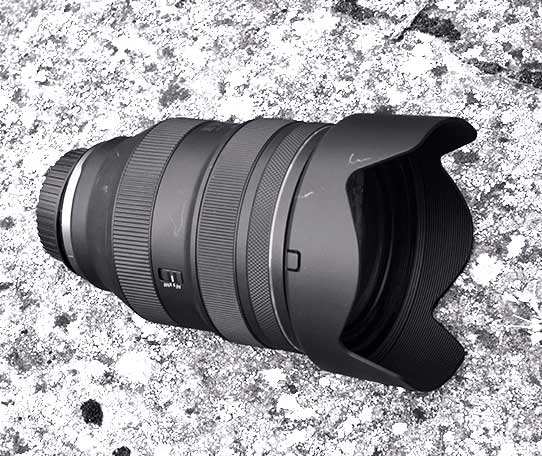Lens overview
Canon’s RF 28–70mm f/2L USM is the first full‑frame standard zoom with a constant f/2 aperture, launched alongside the EOS R system in 2018. It delivers prime‑like speed with a workhorse focal‑length range, weather‑sealed L‑series construction, and ring‑type USM AF. Core specs: 19 elements/13 groups, 9 rounded blades, 0.39 m MFD, 0.18× magnification, 95 mm filters, 1,430 g. There is no optical image stabilization.
Release context. Announced with the RF system on September 5, 2018, with availability from December 2018; original museum listing notes 420,000 JPY. It remains a reference lens in the RF lineup for event and commercial shooters—the lens’s official resource page on Canon’s website.
Build and ergonomics
A large, weather‑sealed L‑series barrel with front control ring and substantial zoom/focus rings. The front element accepts 95mm filters, measuring 139.8mm in length and 103.8mm in diameter, making it front-heavy on smaller bodies but best balanced on R3/R5‑class cameras. Fluorine coatings aid in cleaning. AF is fast and quiet; MF is focus‑by‑wire. No tripod collar is supplied, so a sturdy head is recommended for tripod work.
Optical performance
- Sharpness: Prime‑like center performance at f/2 across much of the range; corners are excellent at 28–40 mm and soften slightly at 70 mm f/2, improving by f/2.8–f/4. Field curvature is low.
- Contrast & color: High native contrast and neutral colors; coatings maintain micro-contrast strength in typical lighting.
- Bokeh: At f/2, the lens can render subject isolation uncommon for a zoom. Highlights remain round from f/2 to f/4, thanks to 9 rounded blades; a slight “onion ring” texture from aspherical elements may appear in specular highlights.
- Flare/ghosting: Well‑controlled during fast zooms, but direct point light sources can still introduce artifacts; use the supplied hood for critical work.
- Distortion: Medium barrel at 28 mm, near‑neutral around 40 mm, mild pincushion at 70 mm; in‑camera corrections mitigate it in JPEG/CR3 workflows.
- Vignetting: Heavy wide‑open (≈ 3 EV at f/2), much improved by f/4; profiles handle it well if enabled.
- Chromatic aberrations: Lateral CA is exceptionally low; some axial LoCA (bokeh fringing) at f/2 that cleans up by f/4.
Historical and collector context
This lens was one of the four launch RF lenses and served as Canon’s “statement piece,” proving the new mount could enable optics previously impractical on EF. It’s also historically notable as the first f/2 standard zoom for full-frame cameras beyond 35mm. Its original U.S. list price was $2,999.
Impressions
Based on multiple independent tests and field reports, this is the quintessential one‑lens solution for weddings and events: f/2 makes focusing easier in poor light and delivers standout subject separation. At the same time, AF speed and reliability are excellent. The trade‑offs are mass/size and no OIS—handheld low‑shutter work depends on the camera’s IBIS.
Sample Photos
Verdict — Pros and Cons
Pros
- Unique f/2 constant aperture in a standard zoom; prime‑like depth of field control.
- Exceptional sharpness and consistency; low lateral CA.
- Fast, accurate AF; professional weather sealing and fluorine coatings.
- Practical 0.39 m MFD / 0.18× for close‑ups.
Cons
- Very heavy/large (1,430 g, 95 mm filters); front‑heavy handling.
- No optical IS (rely on IBIS for stabilization).
- Strong vignetting at f/2; distortion needs profiles.
- The wide end starts at 28 mm (not 24 mm), reducing ultra-wide flexibility without the need for a second lens.
Unmatched speed and image quality for a zoom; weight and size, along with the lack of OIS, are the only real compromises.







